Persian Carpet
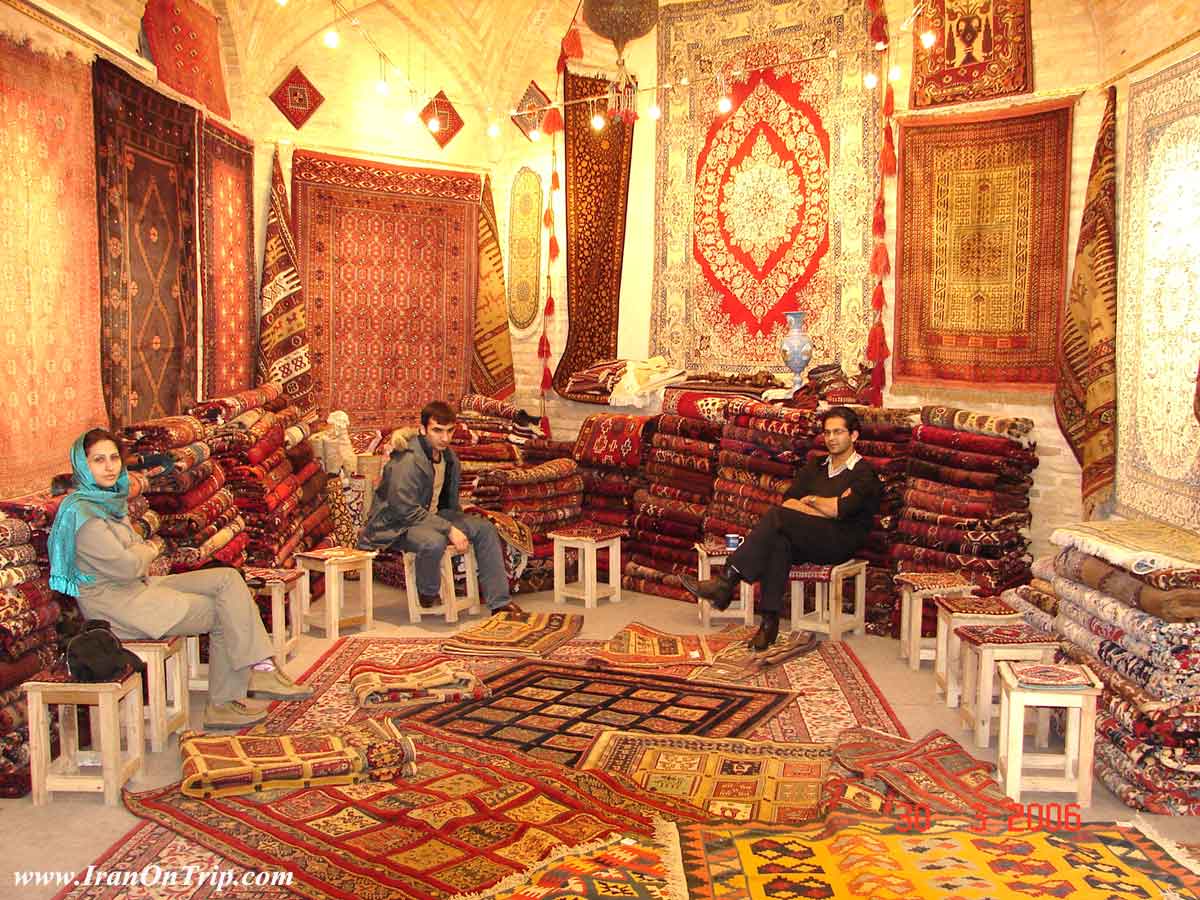
The Persian Rug (Iranian Rug)
Since the distant past, Iranians have been the pioneers in the art of weaving elegant carpets. Dating back to the 5th-century BC, the peerless Pazyryk Carpet was found in the graveyard belonging to one the kings of the Scythian. The patterns on the carpet are reminiscent of the bas-relief of the Achaemenid dynasty and many researchers believe that the current carpet is the same as the ones in the Achaemenid palace, weaving-style wise. What makes Iranian carpet distinct from the others is the elegancy in weaving, variety in drawing and pattern, and natural dying.
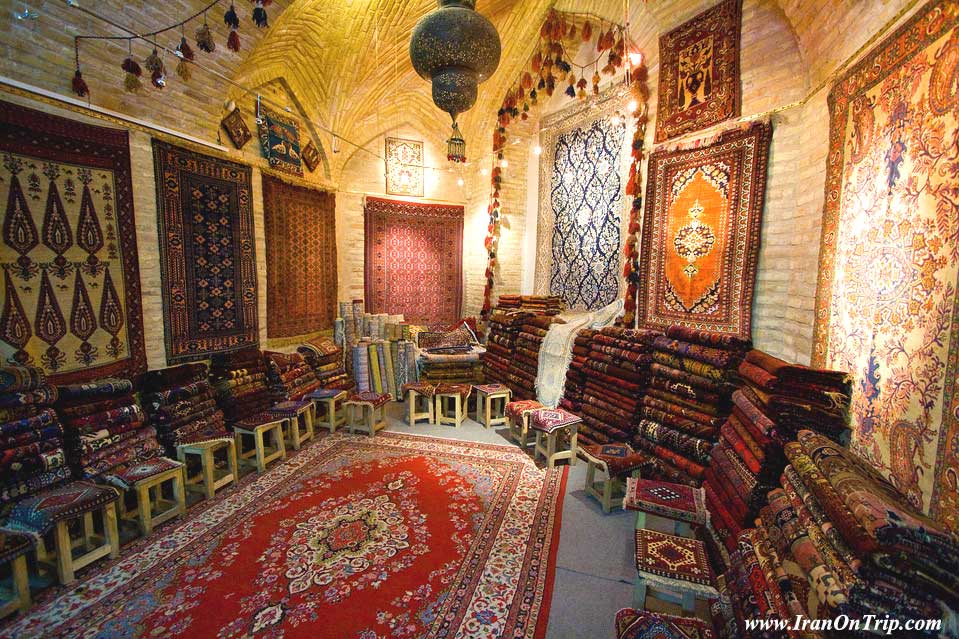
The Persian Carpet(Rug) is an essential part of Persian art and culture. Carpet-weaving is undoubtedly one of the most distinguished manifestations of Persian culture and art, and dates back to the Ancient Persia (c.500 BC). The art of carpet weaving in Iran has its roots in the culture and customs of its people and their instinctive feelings. Weavers mix elegant patterns with a myriad of colors. The Iranian carpet is similar to the Persian garden: full of florae, birds, and beasts.
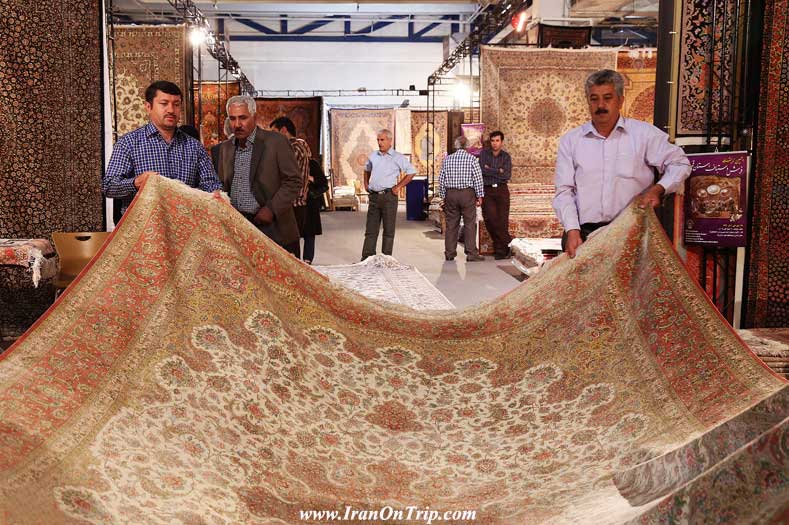
The colors are usually made from wild flowers, and are rich in colors such as burgundy, navy blue, and accents of ivory. The proto-fabric is often washed in tea to soften the texture, giving it a unique quality. Depending on where the rug is made, patterns and designs vary. And some rugs, such as Gabbeh, and Gelim have a variations in their textures and number of knots as well.
The exceptional craftsmanship in weaving these carpets and silken textile thus caught the attention of the likes of Xuanzang, Jean-Baptiste Tavernier, and Jean Chardin.
In the words of Arthur Pope: "All around the world, Iranian carpets are the symbol of poetical luxury.
Wool quality
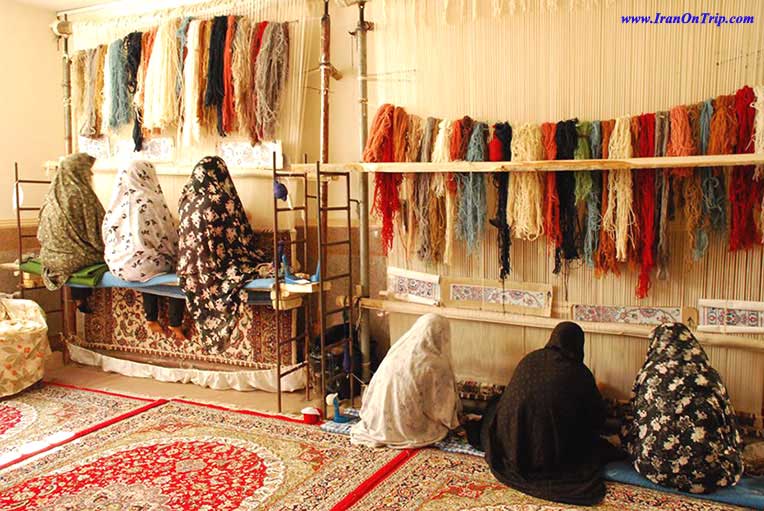
One of the most important factors in the longevity and beauty of a rug is the quality of the wool. We have found that the best carpet wools in the world come from Iran, which is why Iranian rugs have always been the most sought after rugs in the world.
Wool quality is determined by the breed and diets of the sheep from which the wool is shorn. Minerals in their water can give the wool extra strength and luster. Feel the rug, massaging the wool between your fingers. If it feels strong, supple, and rich, as opposed to dry, harsh, and crisp, then the wool is of good quality. One thing to be particularly careful of is "tabatchi" or dead wool. This is wool shorn from sheep that have already been slaughtered. Tabatchi wool is very brittle, and will wear out in a very short time. Rub your hand firmly over a spot on the surface of the carpet a few times. If you have more than a tiny bit of loose wool fiber, it is a likely that the rug is made of tabatchi wool. These rugs should be avoided if possible, as they will wear to nearly nothing and the rug will lose all its value within a span of just a few years.
The best wool is called "kurk". Kurk comes from the first shearing of lambs between 9 and 14 months old, and only from the neck and under the arms. Kurk has a feel almost like velvet, but is exceptionally strong.
Knot count
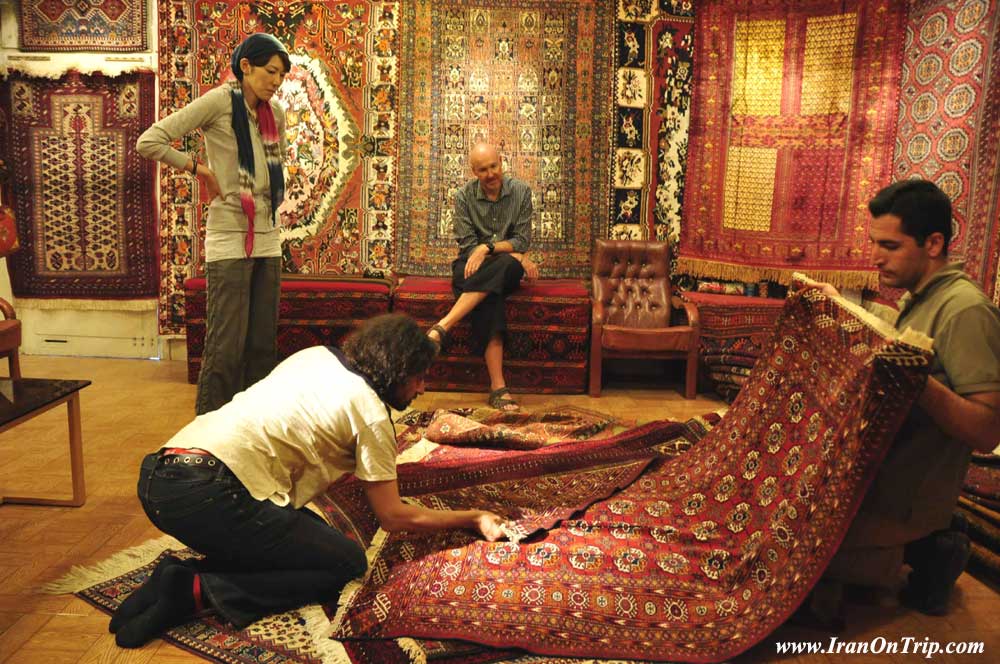
While it’s true that a higher knot count means that the carpet took longer to make, there are other factors to consider. Knot counts in rugs can vary from as low as 40 per square inch to as high as 1200. Think of knots as pixels on a screen. The finer the knot count, the higher the resolution of the picture. Therefore, higher knot counts work best for rugs with a great amount of detail. Curvilinear designs need higher knot counts. Geometric designs can often do with far lower counts and still be very high quality pieces.
In Iran, most knot counts are measured in "radj". One radj is the number of warp threads in 7 centimeters. A 30 raj carpet is usually considered "commercial" grade, with somewhere between 120 and 140 knots per square inch. Carpets of 50 radj and higher are considered fine carpets. A 50 radj carpet usually has about 330 knots per square inch. An 80 raj carpet, has about 900 knots per inch, and is a truly exceptional piece.weavers normally can tie 4,000 up to 8,000 knots a day. This means that a 9' X 12' carpet woven at 350 knots per inch can take over two years for one single weaver to make.
Different Persian carpet
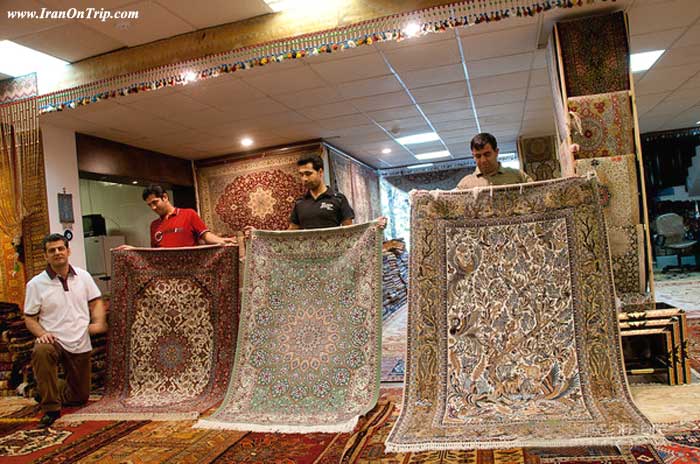
Persian carpets can be divided into three groups; Farsh / Qāli (sized anything greater than 6×4 feet), Qālicheh (قالیچه, meaning "small rug", sized 6×4 feet and smaller), and nomadic carpets known as Gelim (گلیم; including زیلو Zilu, meaning "rough carpet").[2] In this use, Gelim includes both pile rugs and flat weaves (such as kilim and soumak).
Early history
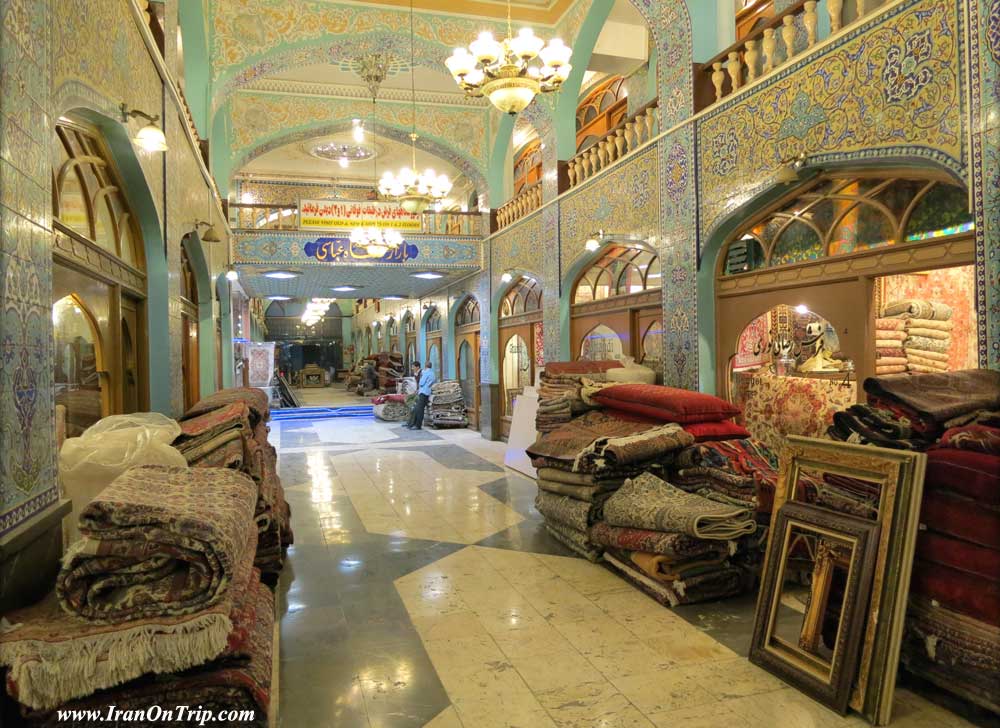
The exceptional Pazyryk carpet was discovered in 1949 in an archaeological excavation in 1949 in the Pazyryk Valley, in the Altai Mountains in Siberia. The carpet was found in the grave of a Scythian prince. Radiocarbon testing indicated that the Pazyryk carpet was woven in the 5th century BC.[14] This carpet is 283 by 200 cm (approximately 9.3 by 6.5 ft) and has 36 symmetrical knots per cm² (232 per inch²).[15] The advanced technique used in the Pazyryk carpet indicates a long history of evolution and experience in weaving. It is considered the oldest known carpet in the world.[16] Its central field is a deep red color and it has two wide borders, one depicting deer and the other Turkish[citation needed] horsemen.
The Pazyryk carpet was thought, by its discoverer Sergei Rudenko, to be a product of the Achaemenids.[17][18] Currently, whether it is a nomadic product with Achaemenid influence, or a product of the Achaemenids remains the subject of debate.[19][20]
Islamic period
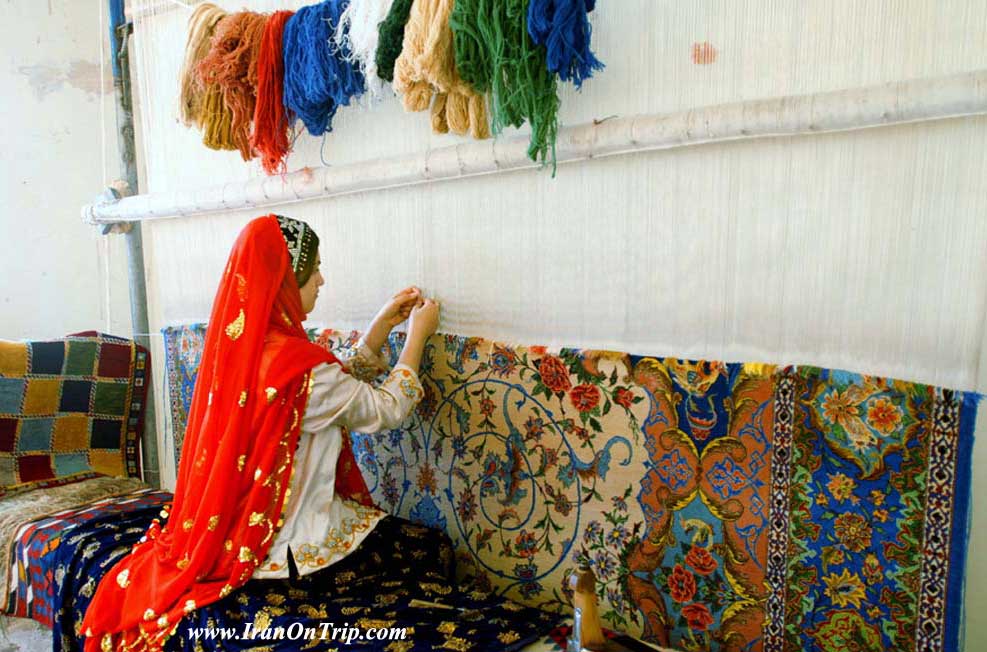
In the 8th century A.D. Azarbaijan Province was among the largest centers of carpet and rough carpet (ziloo) weaving in Persia (Iran). The Province of Tabarestan, besides paying taxes, sent 600 carpets to the courts of caliphs in Baghdad every year. At that time, the main items exported from that region were carpets, and small carpets for saying prayers (also known as prayer mats). Furthermore, the carpets of Khorassan, Sistan and Bukhara, because of their prominent designs and motifs, were in high demand among purchasers.[1] During that era dyeing centers were set up next to carpet weaving looms. The industry began to thrive until the attack on Iran by the Mongol army.[1]
During the reigns of the Seljuq and Ilkhanate dynasties, carpet weaving was still a booming business, and a mosque built by Ghazan Khan in Tabriz, in northwestern Persia, was covered with superb Persian carpets. Sheep were specially bred to produce fine wool for weaving carpets. Carpet designs depicted by miniature paintings belonging to the Timurid era lend proof to the development of this industry at that time. There is also another miniature painting of that time available which depicts the process of carpet weaving. Oriental carpets in Renaissance painting from Europe are often given detailed depictions that help fill in gaps in the record of actual surviving carpets.
The designs share a common style with Persian decoration in other media, such as tilework and non-figurative pages in manuscripts with Persian miniatures. It is thought that the designs for carpets made for the court were made by the court artists and sent to the weavers, and the court commissions led the development of style the used in other works.
The most famous Persian carpet from this period is a large Safavid (1501–1736) example known as the Ardabil Carpet, in the Victoria and Albert Museum in London, which in fact is now a combination of two original carpets, with another piece from the second in Los Angeles.[21] This has been the subject of endless copies ranging in size from small to full scale. There is an 'Ardabil' at 10 Downing Street and even Hitler had an 'Ardabil' in his office in Berlin.[22][23] The carpets were woven in 1539-40 according to the dated inscriptions. The foundation is of silk and the pile of wool with a knot density of 300-350 knots per square inch ( 465-542 thousand knots per square meters). The original size of both carpets was 34 1⁄2 by 17 1⁄2 feet (10.5 by 5.3 metres).[24] Los Angeles County Museum of Art See also Victoria & Albert Museum
There is much variety among classical Persian carpets of the 16th and 17th century. There are numerous sub-regions that contribute distinctive designs to Persian carpets of this period such as Tabriz and Lavar Kerman. Common motifs include scrolling vine networks, arabesques, palmettes, cloud bands, medallions, and overlapping geometric compartments rather than animals and humans. Figural designs are particularly popular in the Iranian market and are not nearly as common in carpets exported to the west.
Modern period
Although carpet production is now mostly mechanized, traditional hand woven carpets are still widely found all around the world, and usually have higher prices than their machine woven counterparts due to them being an artistic presentation. Iran exported $517 million worth of hand woven carpets in 2002. Iran's carpet exports amounted to US$635 million in 2005[dated info], according to the figures from the state-owned Iran Carpet Company. Most are top-notch hand-woven products. In October 2007, National Iranian Carpet Center revealed that hand-woven carpets have ranked first in country's non-oil exports and hold the third position among overall exports. Nearly five million workers are engaged in the Iranian carpet industry, making it one of the biggest enterprises in the country.
In recent times Iranian carpets have come under fierce competition from other countries producing fakes of the original Persian designs as well as genuine cheaper substitutes. Most of the problems facing this traditional art is due to absence of patenting and branding the products as well as reduced quality of raw materials in the local market and the consistent loss of original design patterns. The absence of modern R&D is causing rapid decline in the size as well as market value of this art.
To give one example, the "Carpet of Wonder" in the Sultan Qaboos Grand Mosque in Muscat in the Sultanate of Oman measures 4,343 square metres. Its construction required four years of labour by 600 workers, resulting in 12 million man hours of work.
Materials
Wool is the most common material for carpets but cotton is frequently used for the foundation of city and workshop carpets. There are a wide variety in types of wool used for weaving. Those of which include Kork wool, Manchester wool, and in some cases even camel hair wool. Silk carpets date back to at least the sixteenth century in Sabzevar and the seventeenth century in Kashan and Yazd.[citation needed] Silk carpets are less common than wool carpets since silk is more expensive and less durable; they tend to increase in value with age. Due to their rarity, value and lack of durability, silk carpets are often displayed on the wall like tapestries rather than being used as floor coverings.
Designs, motifs, and patterns
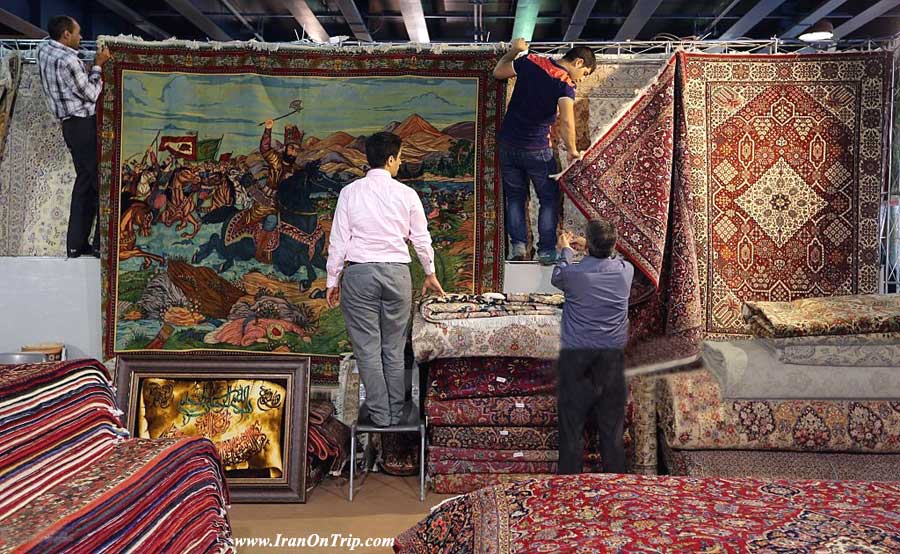
Persian rugs are made up of a layout and a design which in general included one or a number of motifs. The Iran Carpet Company, a specialist in the subject, has attempted to classify Persian carpet designs and has carried out studies of thousands of rugs.[citation needed] Their results show that there have been slight alterations and improvements to almost all original designs. In its classification the company has called the original designs as the 'main pattern' and the derivatives as the 'sub patterns'. They have identified 19 groups, including: historic monuments and Islamic buildings, Shah Abbassi patterns, spiral patterns, all-over patterns, derivative patterns, interconnected patterns, paisley patterns, tree patterns, Turkoman patterns, hunting ground patterns, panel patterns, European flower patterns, vase patterns, intertwined fish patterns, Mehrab patterns, striped patterns, geometric patterns, tribal patterns, and composites.
Design
Design can be described in terms of the manner in which it organizes the field of the rug. One basic design may serve the entire field, or the surface may be covered by a pattern of repeating figures. In areas using long-established local designs, the weaver often works from memory, with the patterns passed on within the family. This is usually sufficient for simple rectilinear design. For the more elaborate curvilinear designs, the patterns are carefully drawn to scale in the proper colours on graph paper. Each square thus becomes a knot, which allows for an accurate rendition of even the most complex design. Designs have changed little through centuries of weaving. Today computers are used in the production of scale drawings for the weavers
Layout
Persian rugs are typically designed using one of four patterns: all-over, central medallion, compartment and one-sided. Some abstract asymmetrical design can be found but most of these can be described as one-sided or unidirectional.
Motifs
There are a number of patterns which are found in Persian and Oriental rugs called 'motifs', these designs have different meanings and tend to be used depending on the area the rug was woven although it is not unusual to find more than one motif in a single rug.
Some of the more common motifs are:
1- Boteh
2- Gul
3- Herati
4-Mina-Khani
5-Rosette
6-Shah Abbasi
7-Azari Kharchang
8-Islimi Floral
Techniques and structures
Long weaving process
The weaving of pile rugs is a difficult and tedious process which, depending on the quality and size of the rug, may take anywhere from a few months to several years to complete.
To begin making a rug, one needs a foundation consisting of warps: strong, thick threads of cotton, wool or silk which run the length of the rug and wefts similar threads which pass under and over the warps from one side to the other. The warps on either side of the rug are normally combined into one or more cables of varying thickness that are overcast to form the selvedge.
Weaving normally begins by passing a number of wefts through the bottom warp to form a base to start from. Loosely piled knots of dyed wool or silk are then tied around consecutive sets of adjacent warps to create the intricate patterns in the rug. As more rows are tied to the foundation, these knots become the pile of the rug. Between each row of knots, one or more shots of weft are passed to tightly pack down and secure the rows.
Depending on the fineness of the weave, the quality of the materials and the expertise of the weavers, the knot count of a handmade rug can vary anywhere from 16 to 800 knots per square inch.
When the rug is completed, the warp ends form the fringes that may be weft-faced, braided, tasseled, or secured in some other manner.
Looms
Looms do not vary greatly in essential details, but they do vary in size and sophistication. The main technical requirement of the loom is to provide the correct tension and the means of dividing the warps into alternate sets of leaves. A shedding device allows the weaver to pass wefts through crossed and uncrossed warps, instead of laboriously threading the weft in and out of the warps.
Horizontal looms
The simplest form of loom is a horizontal; one that can be staked to the ground or supported by sidepieces on the ground. The necessary tension can be obtained through the use of wedges. This style of loom is ideal for nomadic people as it can be assembled or dismantled and is easily transportable. Rugs produced on horizontal looms are generally fairly small and the weave quality is inferior to those rugs made on a professional standing loom.
Vertical looms
Vertical looms are undoubtedly more comfortable to operate. These are found more in city weavers and sedentary peoples because they are hard to dismantle and transport. There is no limit to the length of the carpet that can be woven on a vertical loom and there is no restriction to its width.
There are three broad groups of vertical looms, all of which can be modified in a number of ways: the fixed village loom, the Tabriz or Bunyan loom, and the roller beam loom. The fixed village loom is used mainly in Iran and consists of a fixed upper beam and a moveable lower or cloth beam which slots into two sidepieces. The correct tension is created by driving wedges into the slots. The weavers work on an adjustable plank which is raised as the work progresses.
The Tabriz loom, named after the city of Tabriz, is used in North Western Iran. The warps are continuous and pass around behind the loom. Tension is obtained with wedges. The weavers sit on a fixed seat and when a portion of the carpet has been completed, the tension is released and the carpet is pulled down and rolled around the back of the loom. This process continues until the rug is completed, when the warps are severed and the carpet is taken off the loom.
The roller beam loom is a traditional Turkish village loom, but is also found in Persia and India. It consists of two movable beams to which the warps are attached. Both beams are fitted with ratchets or similar locking devices and completed work is rolled on to the lower beam. It is possible to weave very long rugs by these means, and in some areas of Turkey rugs are woven in series.
Tools
In order to operate the loom, the weaver needs a number of essential tools: a knife for cutting the yarn as the knots are tied; a comb-like instrument for packing down the wefts; and a pair of shears for trimming the pile. In Tabriz the knife is combined with a hook to tie the knots which lets the weavers produce very fine rugs, as their fingers alone are too thick to do the job
A small steel comb is sometimes used to comb out the yarn after each row of knots is completed. This both tightens the weave and clarifies the design.
A variety of instruments are used for packing the weft. Some weaving areas in Iran known for producing very fine pieces use additional tools. In Kerman, a saber like instrument is used horizontally inside the shed, and in Bijar a heavy nail-like tool is used. Bijar is also famous for their wet loom technique, which consists of wetting the warp, weft, and yarn with water throughout the weaving process to make the elements thinner and finer. This allows for tighter weaving. When the rug is complete and dried, the wool and cotton expand to make the rug incredibly dense and strong.
A number of different tools may be used to shear the wool depending on how the rug is trimmed as the rug progresses or when it is complete. Often in Chinese rugs the yarn is trimmed after completion and the trimming is slanted where the color changes, giving an embossed three-dimensional effect.
Knots
Two basic knots are used in most Persian Carpets and Oriental rugs: the symmetrical Turkish or Ghiordes knot (used in Turkey, the Caucasus, East Turkmenistan, and some Turkish and Kurdish areas of Iran), and the asymmetrical Persian or Senneh knot (Iran, India, Turkey, Pakistan, China, and Egypt).
To make a Turkish knot, the yarn is passed between two adjacent warps, brought back under one, wrapped around both forming a collar, then pulled through the center so that both ends emerge between the warps.
The Persian knot is used for finer rugs. The yarn is wrapped around only one warp, then passed behind the adjacent warp so that it divides the two ends of the yarn. The Persian knot may open on the left or the right, and rugs woven with this knot are generally more accurate and symmetrical.
Other knots include the Spanish knot looped around single alternate warps so the ends are brought out on either side and the Jufti knot which is tied around four warps instead
Flat-woven carpets
Flat woven carpets are given their colour and pattern from the weft which is tightly intertwined with the warp. Rather than an actual pile, the foundation of these rugs gives them their design. The weft is woven between the warp until a new colour is needed, it is then looped back and knotted before a new colour is implemented.
The most popular of flat-weaves is called the Kilim. Kilim rugs (along with jewellery, clothing and animals) are important for the identity and wealth of nomadic tribes-people. In their traditional setting Kilims are used as floor and wall coverings, horse-saddles, storage bags, bedding and cushion covers.
Various forms of flat-weaves exist including:
1-Herati
2-Jajim
3-Gelim (Kilim)
3-Maleki
4-Sirjan
5-Soumak (Soumakh)
6-Suzani
Traditional centers of carpet production in Iran (Persia)
The major classical centers of carpet production in Persia were in Tabriz (1500–1550), Kashan (1525–1650), Herat (1525–1650), and Kerman (1600–1650).[citation needed]
The majority of carpets from Tabriz have a central medallion and quartered corner medallions superimposed over a field of scrolling vine ornament, sometimes punctuated with mounted hunters, single animals, or animal combat scenes. Perhaps the best-known of the Tabriz works are the twin Ardabil carpets most likely made for the shrine at Ardabil (today in the collections of the Victoria and Albert Museum in London and the Los Angeles County Museum).
Kashan is known for its silk carpet production, most famously, for the three silk hunting carpet masterpieces depicting mounted hunters and animal prey (currently in the collections of the Vienna Museum of Applied Arts (aka the MAK), the Museum of Fine Arts, Boston, and the Stockholm Palace). The Kashan carpets are among the most valuable in existence.
The Herat carpets, or ones of similar design created in Lahore (Pakistan) and Agra (India), are the most numerous in Western collections. They are characterized by a red field with scrolling vine ornament and palmettes with dark green or blue borders.
The seven classes of Kerman carpet were defined by May Beattie. She identified their unique structure and named it the "vase technique." Carpet types in this group include garden carpets (ornamented with formal gardens and water channels) and the ogival lattice carpets. A fine and well-known example of the latter was purchased by the Victoria and Albert Museum under the guidance of William Morris. The influence of Persian carpets is readily apparent in his carpet designs.
The Seraband rug is produced in Arak.
Anatolian and Persian carpets
The difference between Anatolian (Turkish) and Persian carpets is today largely one of tradition.
Typically, a traditional Persian carpet is tied with a single looping knot (Persian or Senneh Knot), while the traditional Anatolian carpet is tied with a double looping knot (Turkish or Ghiordes Knot). This means that for every 'vertical strand' of thread in a carpet, an Anatolian carpet has two loops as opposed to the one loop for the various Persian carpets that use a Persian 'single' knot. Ultimately, this process of 'double knotting' in traditional Anatolian carpets results in a slightly more block like image compared to the traditional 'single knotted' Persian carpet. The traditional Anatolian style also reduces the number of Knots per sq cm.[citation needed]
Today, it is common to see carpets woven in both Turkey and Iran using either of the two knot styles. When comparing carpets the only way to definitively identify the knot used is to splay open the pile by bending the rug against itself and looking at the base of the knot.
Types of Persian carpets and rugs
Carpet dealers have developed a classification for Persian carpets based on design, type of fabric, and weaving technique.
-
Abadeh
-
Afghan/Yomut (Turkmen)
-
Ahar
-
Afshar
-
Arak
-
Ardabil
-
Ardestan
-
Assadabad rug
-
Bakhtiari
-
Balouch
-
Bijar
-
Birjand
-
Borujerd
-
Chelaberd
-
Chodor
-
Dorokhsh
-
Farahan
-
Ferdos
-
Ghayen
-
Gonabad
-
Gonbad Ghaboos
-
Gorgan
-
Herat
-
Heriz (Hariz)
-
Isfahan
-
Joshghan
-
Jozan
-
Kashan
-
Kashmar
-
Kerman
-
Lilian
-
Mahan
-
Mahalat
-
Maku
-
Mamasani
-
Marand
-
Mashhad
-
Mazlaghan
-
Meshkin Shahr
-
Moshk Abad
-
Mood
-
Nain
-
Nishaboor
-
Rafsanjan
-
Ravar
-
Saraband
-
Sarab
-
Saraband
-
Sarukh
-
Semnan
-
Sha Savan
-
Shahre Kord
-
Shiraz
-
Shahr Reza
-
Qazvin
-
Qom
-
Tabriz
-
Tehran
-
Torghabeh
-
Varamin
-
Yalameh
-
Yazd
-
Zanjan
-
Zabol
Rugs for a specific purpose include:
Most expensive in the world
The most expensive carpet of the world is a 17th-century Persian carpet which was sold in June 2013 in an London auction for $33.8m
Literature
Essie Sakhai:Persian Rugs And Carpets - The Fabric of Life, Antique Collectors' Club Ltd, Suffolk, England, 2008 ISBN 978-1-85149-507-8
Essie Sakhai:Oriental Carpets - a buyer's guide, Parkway Editions LTD, London, England, 1995 ISBN 1-898259-15-1
Essie Sakhai:The Story of Carpets, Random House UK Ltd, London, England, 1991 ISBN 1-85170727-1
Jenny Housego: Tribal Rugs - An Introduction to the Weaving of the Tribes of Iran, Scorpion Publications, London 1978 ISBN 978-0-905906-05-8
Ulrich Schurmann: Oriental Carpets, Octopus Books Limited, London 1979 ISBN 0-7064-1017-3
Ian Bennett: Oriental Rugs, Volume One: Caucasian, Oriental Textile Press Ltd, England, 1981 ISBN 0-902028-58-5
Jan David Winitz: The Guide to Purchasing an Oriental Rug, The Breema Rug Study Society & Dennis Anderson Photo-Publishing, Oakland, 1984 ISBN 0-930021-002 Andrew Middleton: Rugs & Carpets: Techniques, Traditions & Designs, Mitchell Beazley, London 1996 ISBN 1-85732-634-2
Ulrich Schurmann: Caucasian Rugs, Washington International Associates, Accokeek, Maryland, 1974 ISBN 0-915036-00-2
James D. Burns: Visions of Nature: The Antique Weavings of Persia, Umbrage Editions, Iceland, 2010 ISBN 978-1-884167-23-1
See also
Afghan carpet
Baharestan Carpet
Dilmaghani
Flying Carpet
Gabbeh
Gelim (Also Kilim or Kelim)
Heriz rug
Carpet Museum of Iran
Kashan rug
Kashmir rug
Nazmiyal Collection
Oriental rug
Pakistani rug
Tabriz rug
The Poot (Persian Carpet documentary)
Turkish carpet
War rugs
Essie Sakhai (Persian Carpet Expert)
Read more
.....
.....
.....

.jpg)



























